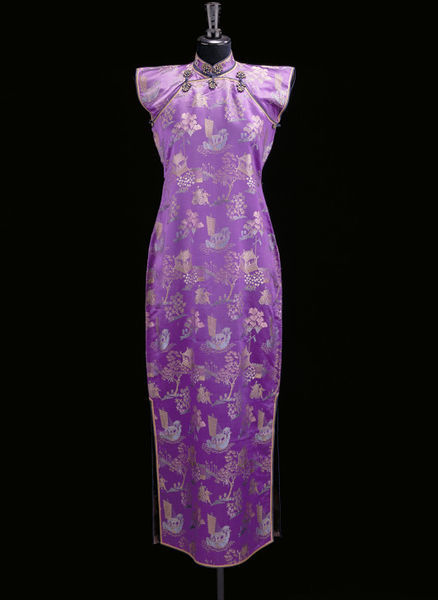#peoples republic of china
Qipao/Cheongsam
20th Century (Probably1960s)
Hong Kong, China
Woven silk
Summary: Woman’s dress (known as a cheongsam in Cantonese or a qipao in Mandarin) made from classic Chinese woven silk with a design of junks and pavilions among traditional trees. It is tailored to accentuate the waist.
The stiffened collar is closed with a triple floret arrangement.
On its own, the qipao is itself a modernised form of the dress worn by Manchu and Han women of the Qing dynasty (1644-1911). During the Republican period (1911-1949), the qipao was promoted as the dress of modern China, identifiably ‘Chinese’ on the one hand, and moving away from 'feudal’ associations with the imperial past.
Post link
photos of ChushiGangdruk, Tibet’s volunteer guerilla army in 1959. They were made up of young males from Amdo and Kham (eastern Tibet) regions that border China.
initially, the US State Department refused to support Chushi Gangdruk, and they were forced to organize their own army and buy their weapons with their own money as well as meager donations from farmers sympathetic to the liberation struggle. After they formed, the CIA provided training and weapons to the troops for a short period, and Taiwan under Chiang Kai-shek funded them temporarily.
Chushi Gangdruk disbanded in 1974, effectively ending the Tibetan liberation movement, after Richard Nixon’s famous olive branch to Mao in 1973 that revived Sino-American relations, thus cutting all funding for the Tibetan freedom cause.
Post link

Now available in the CIA’s Freedom of Information Act Electronic Reading Room: “Nixon and the People’s Republic of China: CIA’s Support of the Historic 1972 Presidential Trip”
Recently released, this collection marks the 50th anniversary of President Richard M. Nixon’s February 1972 trip to the People’s Republic of China (PRC) – a landmark event that preceded the establishment of diplomatic relations between the two countries. It includes a subset of the materials CIA produced for President Nixon and National Security Advisor Henry Kissinger in preparation for the seven-day visit. This trip paved the way for Gerald R. Ford’s visits to the PRC in June 1972 and December 1975.
Learn more and access the materials online here: https://www.cia.gov/readingroom/collection/nixon-collection
Image: President Ford and daughter Susan watch as Secretary of State Henry Kissinger shakes hands with Mao Tse-Tung; Chairman of Chinese Communist Party, during a visit to the Chairman’s residence, 12/2/1975 (National Archives Identifier 7062596, https://catalog.archives.gov/id/7062596)
International Women’s Day is being observed around the world today. The tradition dates back to February 28, 1909, when the Socialist Party of America, acting on the suggestion of party member Theresa Malkiel, held a “National Woman’s Day” in New York City.
The following year, the observance was adopted by the International Socialist Women’s Conference. In the ensuing years, activists for women’s suffrage and other equal rights adopted the date in nations such as Australia, Denmark, Switzerland, and Germany, though the date varied from nation to nation and was sometimes celebrated as the Women’s International Day of Struggle or by other names. However, the observance became most strongly associated with communist nations and the international communist movement; it was officially adopted by the Soviet Union in 1917 and the People’s Republic of China in 1949.
This remained the case until the mid-1960s, when the second-wave feminist movement embraced the day, still operating under various names and dates, as a means of calling further attention to their calls for equal pay, equal economic opportunity, equal legal rights, reproductive rights, subsidized child care, and the prevention of violence against women.
The name and date of International Women’s Day was finally formalized in 1977. The United Nations began observing the day in 1975, as part of its declaration that 1975 would be its International Women’s Year. Two years later, the United Nation’s General Assembly invited its member states to observe the date on March 8.
As a small online observance of the day, we’re posting this photograph of a small group of women strolling on a beachside boardwalk, taken by photographer and illustrator Frank E. Schoonover (1877-1972). The photograph is undated, but was likely taken in the 1910s or 1920s, around the same time that International Women’s Day was first being established worldwide. The photograph is from Hagley Library’s collection of Frank E. Schoonover negatives (Accession 2017.239). This collection has not been digitized in its entirety, but you can view a curated selection of materials online now in our Digital Archive. Just click here!
Post link







